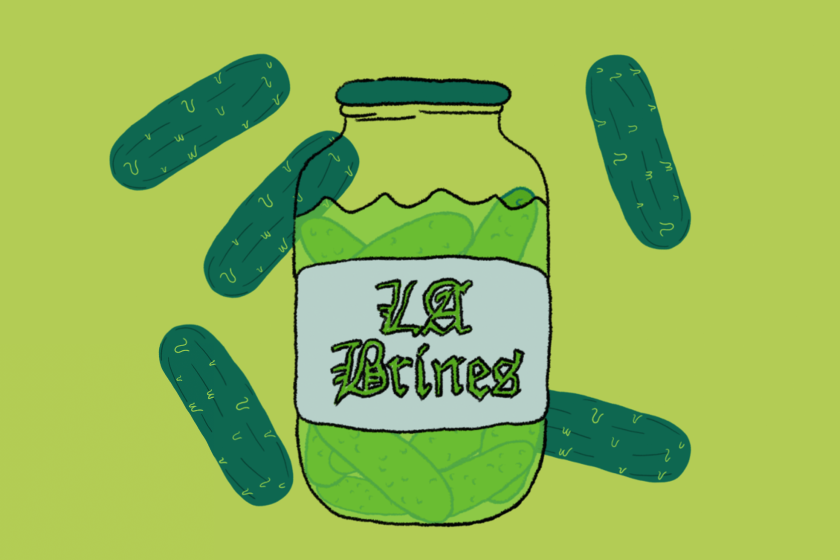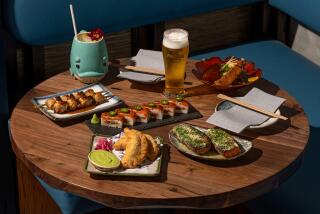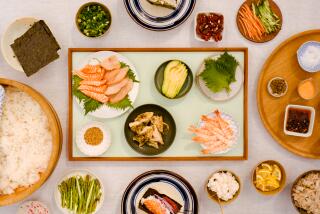Pickled plums are easy to make — so get ready for a new addiction
I’ve been addicted to umeboshi (Japanese pickled plums) since I was a kid who didn’t like much else, but I never thought to make my own until the pandemic-instigated lockdown. By the time I took my first nervous post-COVID-19 trip to Marukai in Little Tokyo, ume season was just getting going.
You might recognize the pink, salty, puckery, squishy, wrinkly-skinned preserved fruit if you’ve ever had one stuffed into the center of onigiri (Japanese rice balls). I loved them in my favorite childhood snack, umekyu: cut rolls with sheets of dried seaweed and sushi rice wrapped around cucumbers and umeboshi paste. One of the first dishes I learned to cook for myself in college was spaghetti with butter, umeboshi paste and shiso.
It wasn’t until a couple of years ago that I noticed fresh ume, which is a Prunus variety more closely related to apricot than plum, at farmers markets in Southern California. Nicholas Family Farms, based in Fresno, sells them at local Los Angeles markets from April to June. Japanese grocery stores set up seasonal ume stands, alongside displays of special plastic jugs dedicated to steeping the fruit with rock sugar and white liquor for a cordial called umeshu.
Sour plums aren’t eaten raw because they’re too astringent; traditionally, they’re preserved in a few different ways, and their preparation is collectively known as ume shigoto, or ume work. For umeboshi, all you need are the plums (preferably at peak ripeness) and fine sea salt, so I set out to do the work.
I weighed the plums, then enough salt so that it amounted to 8% of the weight of the fruit. Using a cake tester, I carefully removed and discarded the nubby stems at the top of the fruit, careful not to break the skin. I rinsed the plums thoroughly in a colander and let them dry overnight. Mixed with the salt, the plums are meant to sit, covered and weighted, for three (and up to several) weeks in a cool, dark place on your counter.
Where to find different kinds of pickles in L.A., including kimchi, pickled herring, achaar, kosher dills and more.
I used a clean large ceramic bowl because I wanted easy access to them during the process. I covered it with plastic wrap that touched the surface of the fruit, placed another slightly smaller bowl on top and into that put canned goods, pie weights and some dried beans — the total should be as heavy as the fruit.
Within about a week, liquid released from the fruit was supposed to rise enough to cover the plums entirely. Because mine weren’t at peak ripeness, they never released that much liquid, so I added a splash of vodka. I also gave the fruit a stir every couple of days, replacing the plastic wrap as needed.
When, after two weeks, the liquid was finally near the top, I added salted red shiso (take a handful of shiso, sprinkle with a couple pinches of salt and massage it into the leaves). Red shiso gives the material a natural pink color (store-bought umeboshi often contains dyes — another reason to make your own).
When the plums were soft and wrinkled (mine took four to five weeks), I alternately dried them on bamboo racks in the sun and returned them to their brine overnight for three days. I also dried most of the shiso leaves (to be ground for shiso powder), and I use the brine, called umesu, like vinegar.
The umeboshi live in a covered jar in the refrigerator, where they’ll improve with age — even better next year. Hope it’s the same for me.
More to Read
Eat your way across L.A.
Get our weekly Tasting Notes newsletter for reviews, news and more.
You may occasionally receive promotional content from the Los Angeles Times.












